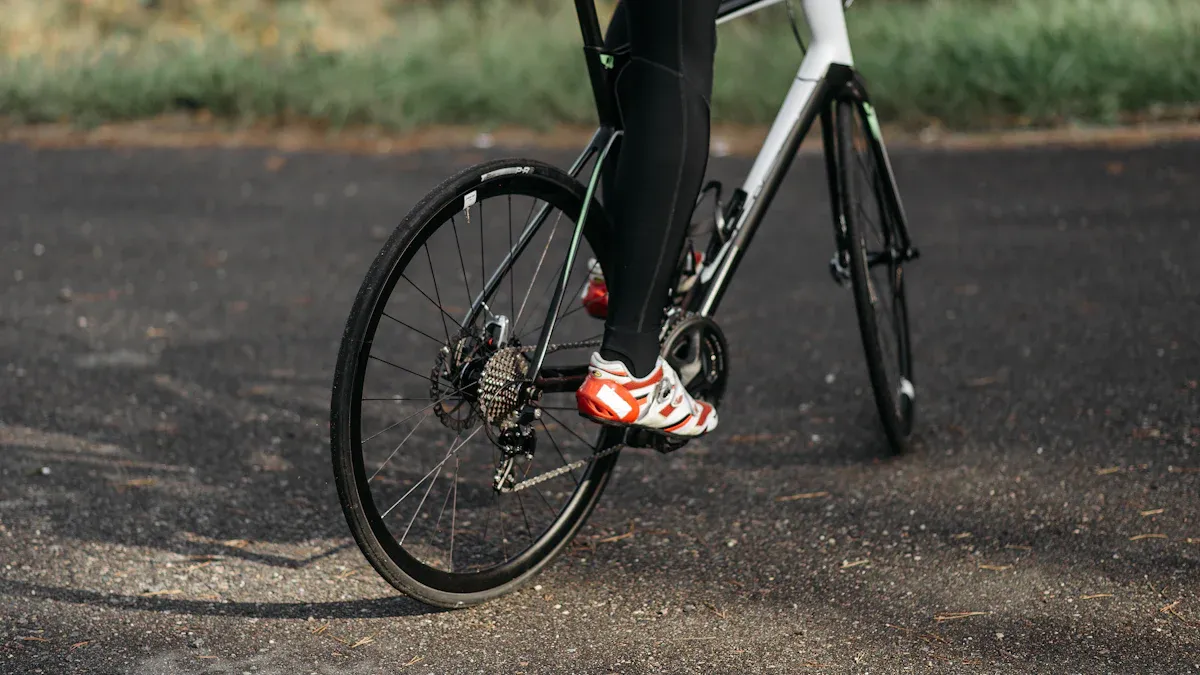
If you stand between 5’8″ and 6’1″, you likely fit a large bike frame size. Still, every bike type has its own sizing rules. Check out this table to see how different bikes match up with your height:
Bike Type | Rider Height Range for Large Frame |
|---|---|
Road Bike | 5’8″ – 5’10” |
Mountain Bike | 5’10” – 6’1″ |
Hybrid/City Bike | 5’10” – 6’1″ |
Triathlon Bike | 5’9″ – 6’0″ |
Your inseam and reach matter just as much as your height. Sometimes, your legs or arms make a big difference in finding the right large bike frame size.
Key Takeaways
Match your height and inseam to the bike type’s size chart to find the right large frame.
Check frame geometry like stack and reach, not just seat tube length, for a better fit.
Try test rides and adjust seat height, stem length, and handlebars to improve comfort.
Choose a smaller frame for speed and control or a larger frame for comfort and relaxed riding.
Visit a bike shop for expert advice and to compare sizes before buying your bike.
Large Bike Frame Size
Height Range
When you look for a large bike frame size, you want to match your height to the right frame. Most brands suggest a large frame if your height falls between about 5’8.9″ and 6’1.2″. Some brands stretch this range a bit, especially for road bikes, which can fit riders up to 6’5″. Here’s a quick look at how different bikes match up with rider height:
Bike Type | Frame Size (cm/in) | Rider Height Range (cm) | Rider Height Range (ft/in) |
|---|---|---|---|
Road Bike | 56-61 cm | 5’10” – 6’5″ | |
Mountain Bike | 19.5″ (Large) | 5’9.7″ – 6’2.0″ | |
Hybrid Bike | 19″ – 22″ | 175 – 198 | 5’9″ – 6’6″ |
You can see that the large bike frame size covers a wide range of heights. Some brands offer more size options, while others use bigger jumps between sizes. That’s why you might see a large frame fitting a slightly different rider height depending on the brand.
Tip: Always check the brand’s size chart before you buy. Each company measures frames a little differently.
Inseam Range
Your inseam is just as important as your height when picking a large bike frame size. Most large frames work best for inseams between 32.3″ and 34.6″ (about 82 to 88 cm). Some road bikes for taller riders can fit inseams up to 38″. But here’s the tricky part: not all brands measure frames the same way. For example, a 62cm frame from one brand might feel smaller than a 60cm from another because of differences in stack and reach.
Rider Height (cm) | Inseam Range (cm) | Frame Size (cm/in) | Frame Label |
|---|---|---|---|
81 – 85 | 47 – 49 | Large (L) | |
184 – 193 | 85 – 90 | 50 – 52 | Large (L) |
187 – 196 | 90 – 94 | 53 – 54 | XL |
Manufacturers often use stack (vertical height) and reach (horizontal length) to help you find the right fit. These numbers can change how a large bike frame size feels, even if the seat tube length looks the same.
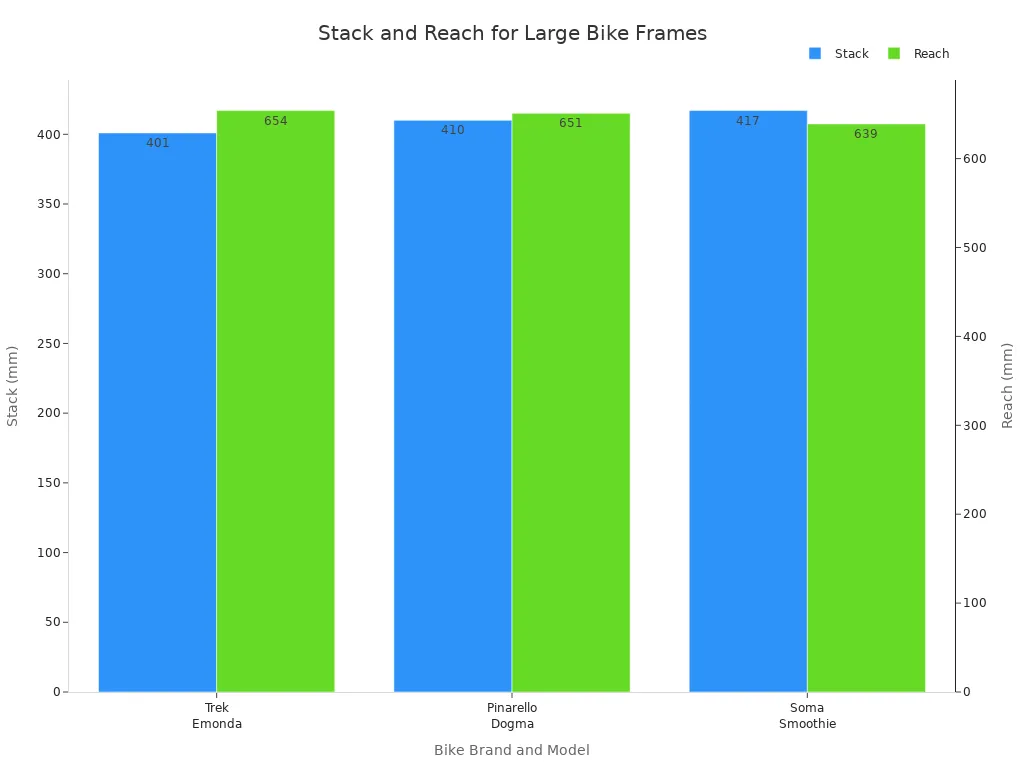
Note: Don’t just look at the seat tube length. Check the geometry chart for stack and reach, or ask for help at your local bike shop.
Variations by Bike Type
Not all large bike frame sizes are created equal. Road bikes, mountain bikes, and hybrid bikes each use different sizing systems and frame shapes. Here’s what you need to know:
Road Bikes: These use centimeters for sizing and focus on seat tube length. Large frames usually run from 56cm to 62cm. Road bikes have more size options, so you can find a closer fit for your height.
Mountain Bikes: These use inches or centimeters and often have broader size categories like L, XL, and XXL. A large mountain bike frame fits riders from about 5’9.7″ to 6’2″. The geometry is different, too, with a focus on standover height and a more upright position.
Hybrid Bikes: These size like mountain bikes but often use inches. Large hybrid frames usually range from 19″ to 22″ and fit riders from 5’9″ to 6’6″. Hybrids have shorter top tubes and a more relaxed fit.
Some brands, like Trek, even offer different fit options for the same frame size. You might see labels like H1, H2, or H3, which change the handlebar height and reach. This means two bikes with the same large bike frame size can feel very different.
Good news: There’s no difference in large bike frame size recommendations for men and women. Both can use the same size charts. Some brands offer women-specific models, but the main sizing stays the same.
If you want the best fit, always check the brand’s chart and try the bike in person. Frame geometry, stack, and reach can change how a bike feels, even if the size label matches your height and inseam.
Bike Frame Size Guide
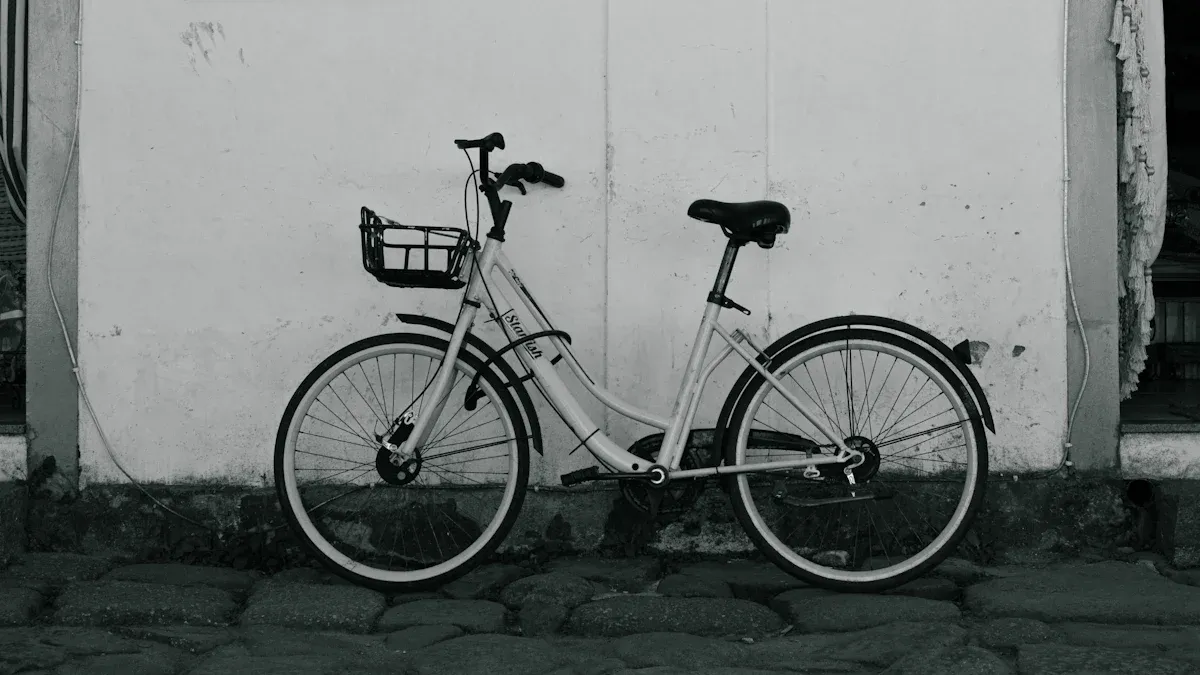
Size Chart
You want a bike that fits you just right. A good bike size guide makes this easy. First, grab a tape measure and follow these steps:
Place a book between your legs, spine up, to copy the saddle height.
Measure from the floor to the top of the book. This is your inseam.
Measure your height from the floor to the top of your head.
Now, check out this typical bike size guide. It matches frame sizes to both rider height and inseam. You can use it for road, mountain, and hybrid bikes.
Bike Type | Frame Size | Rider Height | Inseam Range |
|---|---|---|---|
Road Bike | 58 cm | 33.1″ – 34.3″ | |
Road Bike | 60 cm | 6’0.8″ – 6’2.8″ | 33.9″ – 35.4″ |
Road Bike | 62 cm | 6’2.8″ – 6’4.8″ | 35.0″ – 36.2″ |
Mountain Bike | L (19.5″) | 5’9.7″ – 6’2″ | 32.7″ – 34.6″ |
Hybrid Bike | L (19″-22″) | 5’9″ – 6’6″ | 32.3″ – 36.2″ |
Tip: Always use both your height and inseam when checking bike sizing charts. This helps you find the best fit for comfort and control.
How to Use the Guide
You might wonder how to use this bike frame size guide for your next ride. Here’s what you should do:
Start by measuring your height and inseam. These numbers are your starting point.
Look at the bike size guide chart. Find the row that matches your measurements.
Notice that road bikes use centimeters for frame size, while mountain and hybrid bikes often use inches or size labels like L or XL.
Check the fit for your bike type. Road bikes focus on reach and stack, which affect how stretched out or upright you feel. Mountain bikes care more about standover height for safety and control. Hybrid bikes mix both styles.
Remember, the guide gives you a starting point. Your body proportions, like long legs or a short torso, can change what feels best.
Try not to rely only on the size label (like Large or XL). Different brands use different measurements for the same label.
If you ride for speed, you might want a smaller frame for a lower, more aggressive position. If you want comfort, a bigger frame with a more upright fit could work better.
Here are some common mistakes to avoid:
Don’t pick a bike just by wheel size. Wheel size does not decide the frame fit for adults.
Don’t ignore your inseam. It matters more than just your height.
Don’t skip checking the reach. This is the distance from the seat to the handlebars. You can’t change this much after you buy the bike.
Don’t assume all brands use the same sizing. Always check the chart for each brand.
Note: If you feel unsure, visit a bike shop for a test ride. Experts can help you double-check your fit and answer questions about frame geometry.
A bike frame size guide helps you get started, but your comfort and riding style matter most. Use the guide, measure carefully, and always test the bike if you can. That way, you’ll enjoy every ride.
Fit Confirmation
Inseam Measurement
Getting your inseam right is the first step toward a perfect fit. You want to measure from the floor to the top of your inner thigh, just like you would for saddle height. Here’s a simple way to do it:
Stand straight against a wall with your shoes off.
Place a book between your legs, spine up, to mimic the saddle.
Measure from the floor to the top of the book.
You can use your inseam to estimate frame size by multiplying it by two-thirds. Manufacturer size charts give you a starting point, but they don’t always guarantee a perfect fit. If you want the most accurate results, visit a professional bike fitter. They use advanced tools to measure your inseam, saddle height, and other body parts. Bike shop experts can also help you test ride different frames and check your comfort.
Tip: Demo rides and expert advice help you confirm if a large bike frame really matches your inseam and riding style.
Body Proportions
Your body proportions play a huge role in finding the perfect fit. You might have long legs and a short torso, or the opposite. Riders with short legs and long torsos often need a larger frame for reach, but must watch crank length. If you have long legs and a short torso, you may need a smaller frame to keep the handlebars close and the saddle height right. Flexibility matters too. Tight hamstrings or a stiff back can make a lower saddle height and shorter reach more comfortable.
Handlebar width and crank length should match your proportions for comfort and control.
A professional fitting looks at your leg length, torso, and arm length. This helps you avoid pain and get the perfect fit for your riding style.
Stand-Over and Reach
Standover height is key for safety and comfort. You want enough clearance between the top tube and your body when you stand over the bike. For large frames, the recommended standover height varies by bike type:
Frame Type / Feature | Standover Clearance Recommendation (cm less than PBH) | Reach and Handlebar Notes |
|---|---|---|
Roadish bikes with horizontal top tubes | 0 to 2 cm less | Larger frames allow higher handlebars with minimal or no increase in reach; reach ~40 cm for large frames. |
Roadish bikes with sloping top tubes | 2 to 3 cm less | Bars get higher and closer with bigger frames; stem length can adjust reach if needed. |
Off-road / ATB bikes | 3 to 5 cm less | Higher standover clearance recommended for safety and comfort. |
Fat bikes | 5 to 10 cm less | Extra clearance needed for riding in deep snow or rough terrain. |
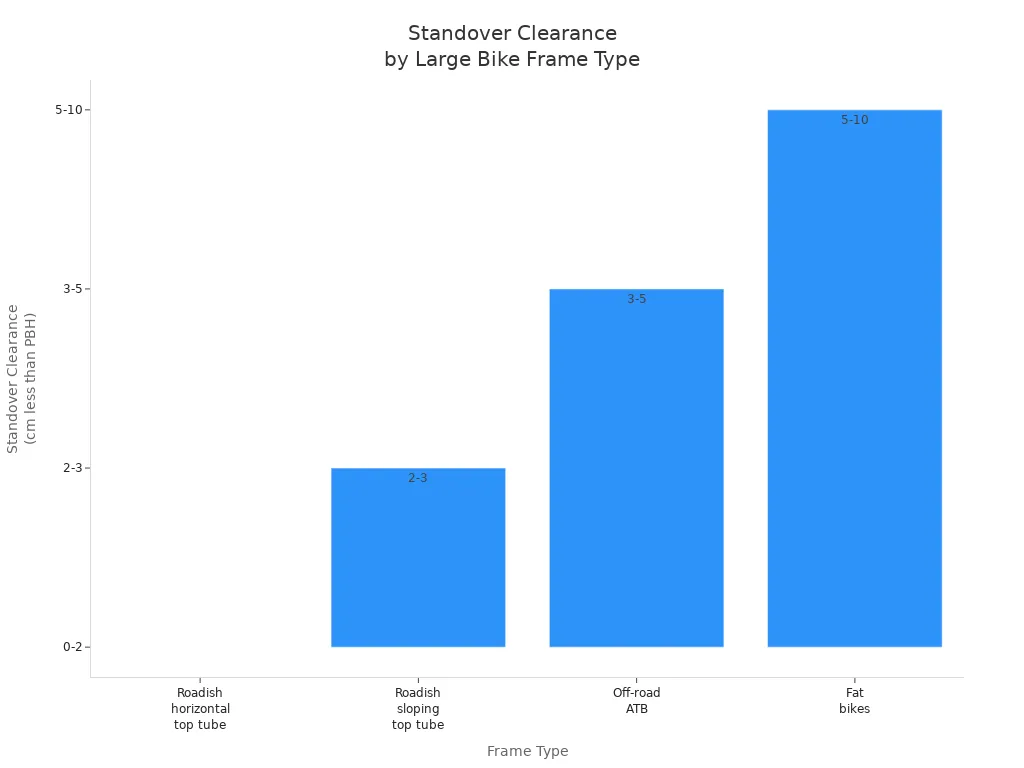
You should always check standover height before buying. Larger frames give you higher handlebars, which can improve comfort. Reach doesn’t always increase with frame size, since you can adjust stem length. Saddle height should be set so your legs work efficiently and you avoid strain. A perfect fit means you feel confident, comfortable, and in control every time you ride.
Remember: The right standover height, saddle height, and reach help prevent pain and boost your performance. You’ll enjoy longer rides and better handling with a perfect fit.
Between Sizes
Sizing Up or Down
You might find yourself stuck between two large bike frame sizes. Don’t worry—this happens to lots of riders. The choice depends on how you want your bike to feel. If you love speed and a lively ride, go for the smaller frame. It gives you a more dynamic position and helps you handle the bike better. If comfort matters most, pick the bigger frame. You’ll get a more relaxed posture, which is great for longer rides.
Pro tip: For road bikes, experts often suggest sizing down if you’re between sizes. You’ll get a lower, more aerodynamic position and better control.
Here’s a quick table to help you decide:
Riding Style | Frame Choice | Why Choose It? |
|---|---|---|
Fast & Sporty | Smaller Frame | Quicker handling, lower fit |
Relaxed & Comfy | Larger Frame | Upright posture, softer ride |
No matter what, your perfect fit comes from how the bike feels when you ride it. Try both sizes if you can.
Adjustment Tips
You can tweak a bike to get closer to your perfect fit, even if you’re between sizes. Here are some easy ways to adjust your bike:
Change the seat post height to match your inseam.
Adjust the stem length for better reach.
Move the saddle forward or backward to fine-tune your position.
Pick handlebars that match your shoulder width.
Add spacers under the stem to raise the handlebars.
Most riders find that these changes help a larger frame feel just right. You can usually adjust about two frame sizes with these tricks. If you need extreme changes, the frame might be too big or too small. A professional fitting or a test ride helps you find your perfect fit and avoid pain or injury.
Remember: Your comfort matters most. Try different setups until you find the perfect fit for your body and riding style.
Test Ride Tips
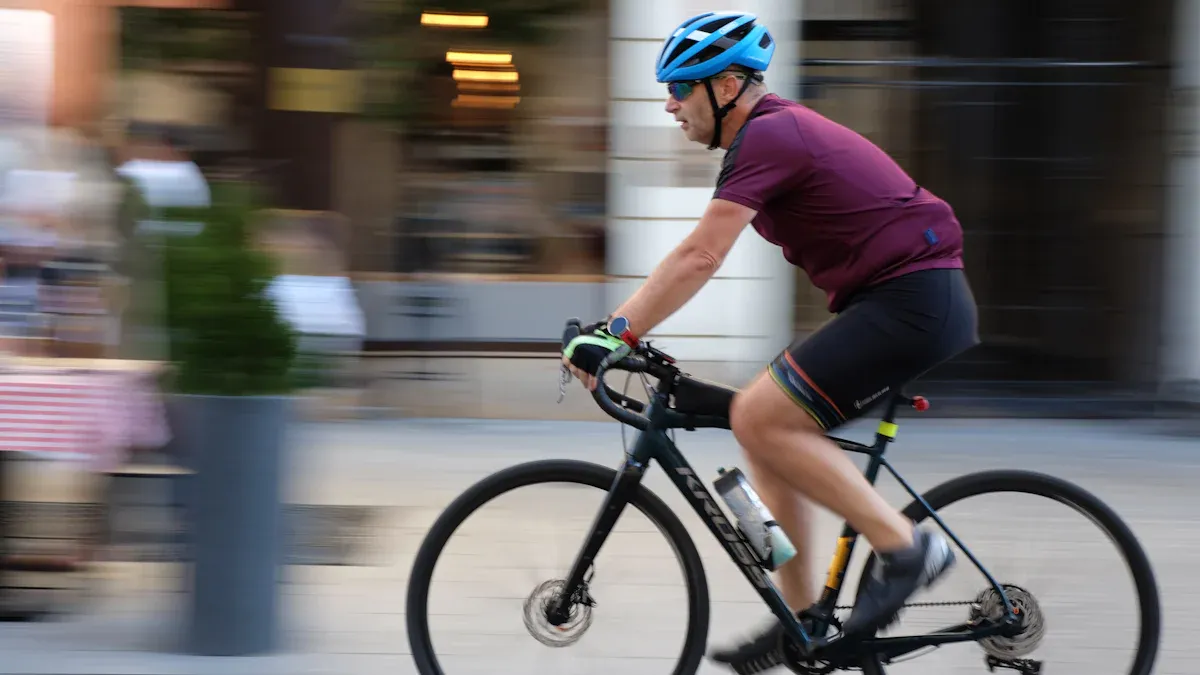
Bike Shop Advice
When you visit a bike shop, you get more than just a place to buy a bike. You get expert help to find the right fit. Bike shop staff often suggest you test ride several bikes in your size range. This helps you feel the difference between frame sizes and styles. They will check your height and inseam, then compare those numbers to the manufacturer’s chart. You can see a typical size chart below:
Rider Height (cm) | Leg Inseam (cm) | Recommended Frame Size (cm) | Frame Size Label |
|---|---|---|---|
180 – 190 | 81 – 85 | 47 – 49 | Large (L) |
184 – 193 | 85 – 90 | 50 – 52 | Large (L) |
187 – 196 | 90 – 94 | 53 – 54 | Extra Large (XL) |
190 – 200 | 94 – 97 | 55 – 57 | Extra Large (XL) |
195+ | 97+ | 58 – 59 | Double Extra Large (XXL) |
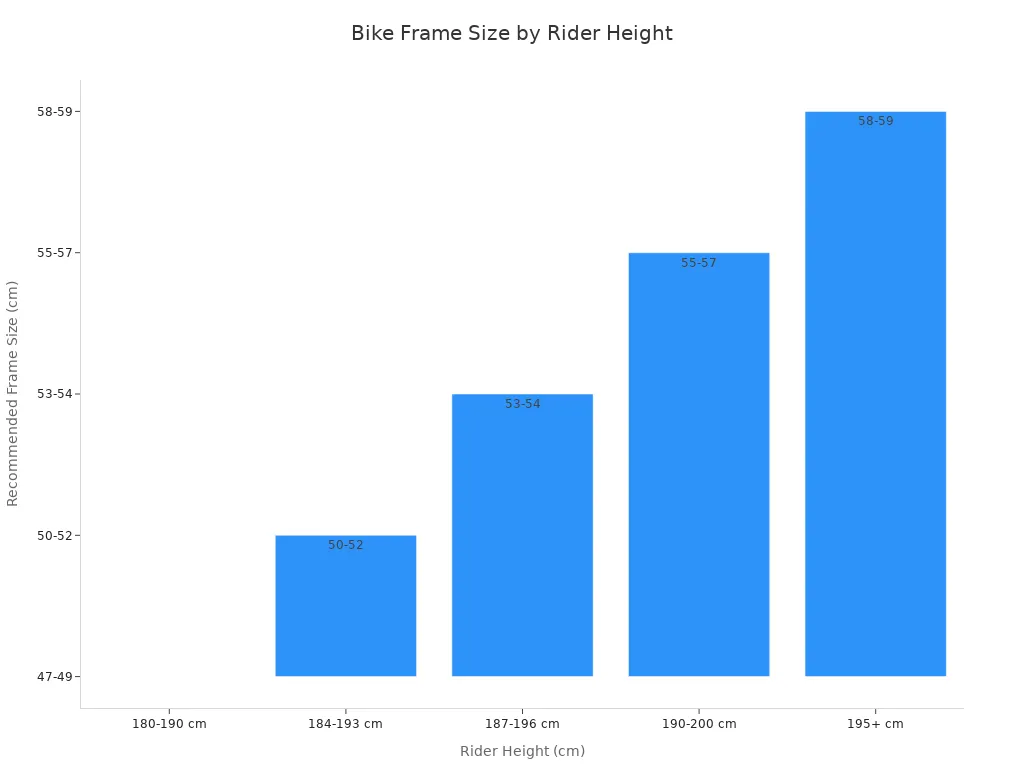
Bike shop pros will also talk about reach and stack. They want you to have a bike that feels good, not just one that matches a chart. Sometimes, they may suggest a women’s or teen frame if it fits you better. Don’t be afraid to ask questions. The staff can guide you through the process and help you compare different bikes.
Tip: Always test ride more than one size. You might be surprised by which one feels best.
Comfort Check
A test ride is your chance to see how the bike feels in real life. Numbers and charts are helpful, but your comfort matters most. Here’s what you should look for during your ride:
Check if you can stand over the frame with about 5cm of clearance.
Make sure the saddle height lets your knee bend slightly at the bottom of the pedal stroke.
Notice if the handlebars are easy to reach without stretching or feeling cramped.
Pay attention to how the bike handles. You want to feel in control, not wobbly or unstable.
Try riding on different surfaces if possible. See how the bike responds to turns and bumps.
If something feels off, try another size or ask the shop to adjust the seat or handlebars. Sometimes, a small change makes a big difference. A good guide will remind you that comfort and control are more important than just matching numbers. Trust how your body feels. If you feel confident and happy on the bike, you’ve likely found the right size.
Mountain Bike Frame Size
Height Recommendations
When you look for the right mountain bike frame size, your height gives you a good starting point. Most large mountain bike frames fit riders from about 5’10” to 6’1″. Some brands stretch this range a bit, so always check the size chart for the bike you want. Here’s a quick table to help you match your height to the right frame:
Rider Height | Frame Size Label | Frame Size (inches) |
|---|---|---|
5’10” – 6’1″ | Large (L) | 19″ – 20.5″ |
6’1″ – 6’4″ | Extra Large (XL) | 21″ – 22.5″ |
You might notice that mountain bikes use inches or size labels like L and XL. These sizes can feel different from road or hybrid bikes. Always check the standover height and reach, not just the label.
Tip: If you fall between two sizes, try both. Sometimes a smaller frame feels more playful, while a bigger one gives you more stability.
Special Considerations
Choosing a mountain bike frame size is about more than just your height. You need to think about your inseam, torso length, and arm length. These body measurements help you find a frame that feels right and keeps you comfortable on the trail.
Check the seat tube length. This helps you know if the frame will fit your legs.
Make sure you have at least 2 inches of standover clearance. This space lets you get off the bike quickly and safely. Aggressive riders sometimes want even more clearance.
Standover height can change with different tires and top tube shapes. Always measure with the tires you plan to use.
Set your saddle height so your knee has a slight bend when the pedal is at the lowest point. This helps you ride longer without pain.
Pay attention to your foot position and cleat alignment. Good alignment keeps you comfortable and lowers your risk of injury.
Try out different stem lengths and handlebar positions. These small changes can make a big difference in how the bike handles.
Think about the type of mountain biking you want to do. Cross-country, trail, and enduro bikes all have different frame shapes and suspension setups.
Test ride a few bikes if you can. A professional fitting helps you find the best match, especially if you have longer legs or arms.
Remember: The best mountain bike frame size gives you control, comfort, and confidence on every ride.
Finding the right large bike frame means matching your height and inseam to the right size. Here’s a quick look at the typical ranges:
Bike Type | Rider Height Range | Frame Size Range | Inseam Range |
|---|---|---|---|
Road Bike | 5’9″ – 6’0″ | 56cm – 58cm (Large) | 33.5″ – 35.5″ |
Mountain Bike | 5’6″ – 5’10” | 17″ – 18″ (Large) | 33″ – 35.5″ |
Hybrid Bike | 5’6″ – 5’10” | 17″ – 18″ (Large) | 33.5″ – 35.5″ |
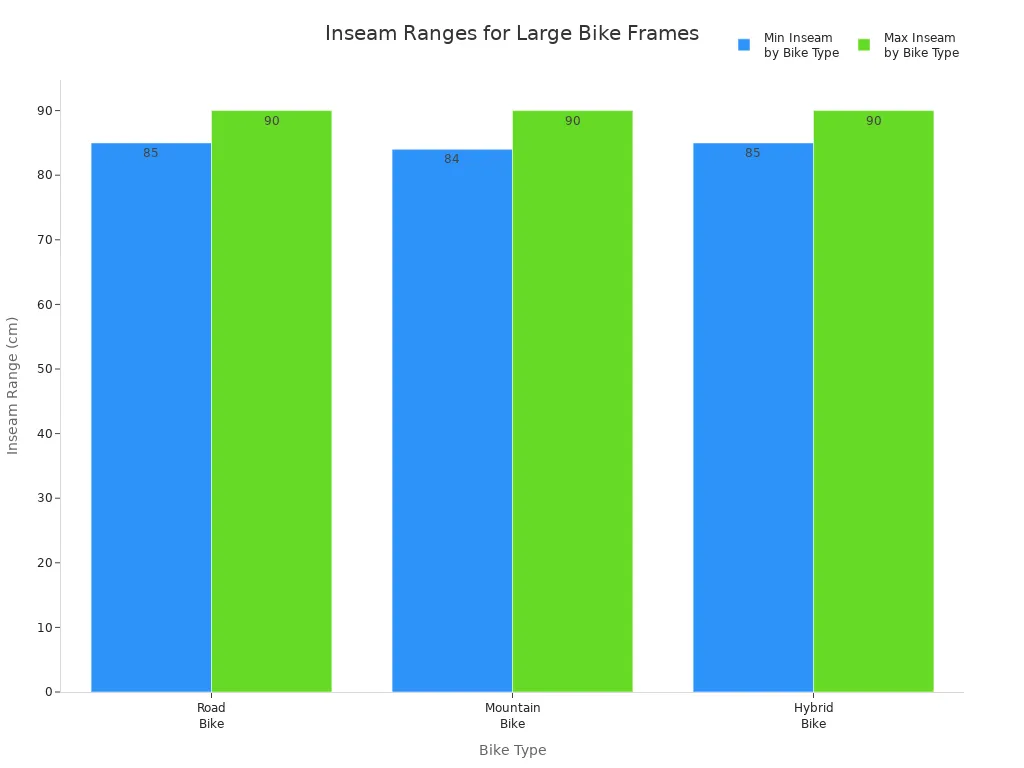
You can use online size guides to get started, but nothing beats trying a bike in person. Here’s why:
Online charts give you a good starting point.
In-person fits let you adjust for comfort, flexibility, and riding style.
Test rides help you feel the difference between brands and models.
Trust your body and use these tips to find a bike that feels just right. Happy riding! 🚴♂️
FAQ
What if my height fits a large frame, but my inseam is shorter?
You might feel more comfortable on a medium frame. Try both sizes if you can. Adjust the seat height and see which bike feels better. Your comfort matters most.
Can I use the same size for road and mountain bikes?
Not always. Road and mountain bikes use different sizing systems. You may need a different size for each type. Always check the size chart for the bike you want.
How do I know if my bike is too big or too small?
If you struggle to reach the handlebars or stand over the frame, the bike may be too big. If you feel cramped or your knees hit the handlebars, the bike may be too small.
Do women need a different large frame size than men?
No, most brands use the same size charts for everyone. Some brands offer women-specific models, but the main sizing stays the same. Always check the fit and comfort.
Should I buy a bike online or in a shop?
A bike shop lets you test ride and get expert advice. Online shopping gives you more choices. If you buy online, measure carefully and check the return policy.
See Also
Complete Guide To Racing Bike Frame Sizes For Riders
Simple Steps To Discover Your Perfect Downhill Bike Frame
Understanding Mountain Bike Geometry To Pick The Right Size
